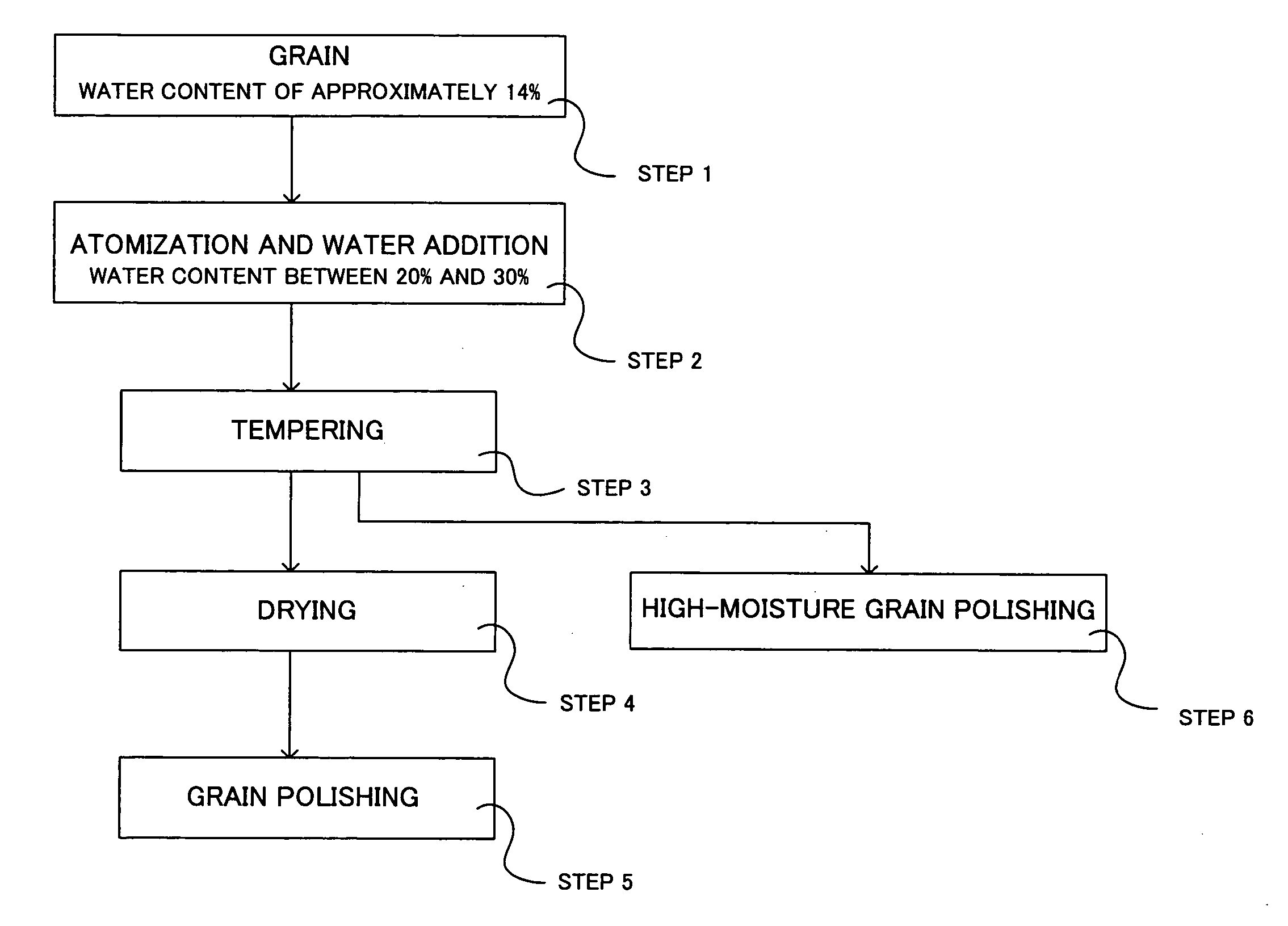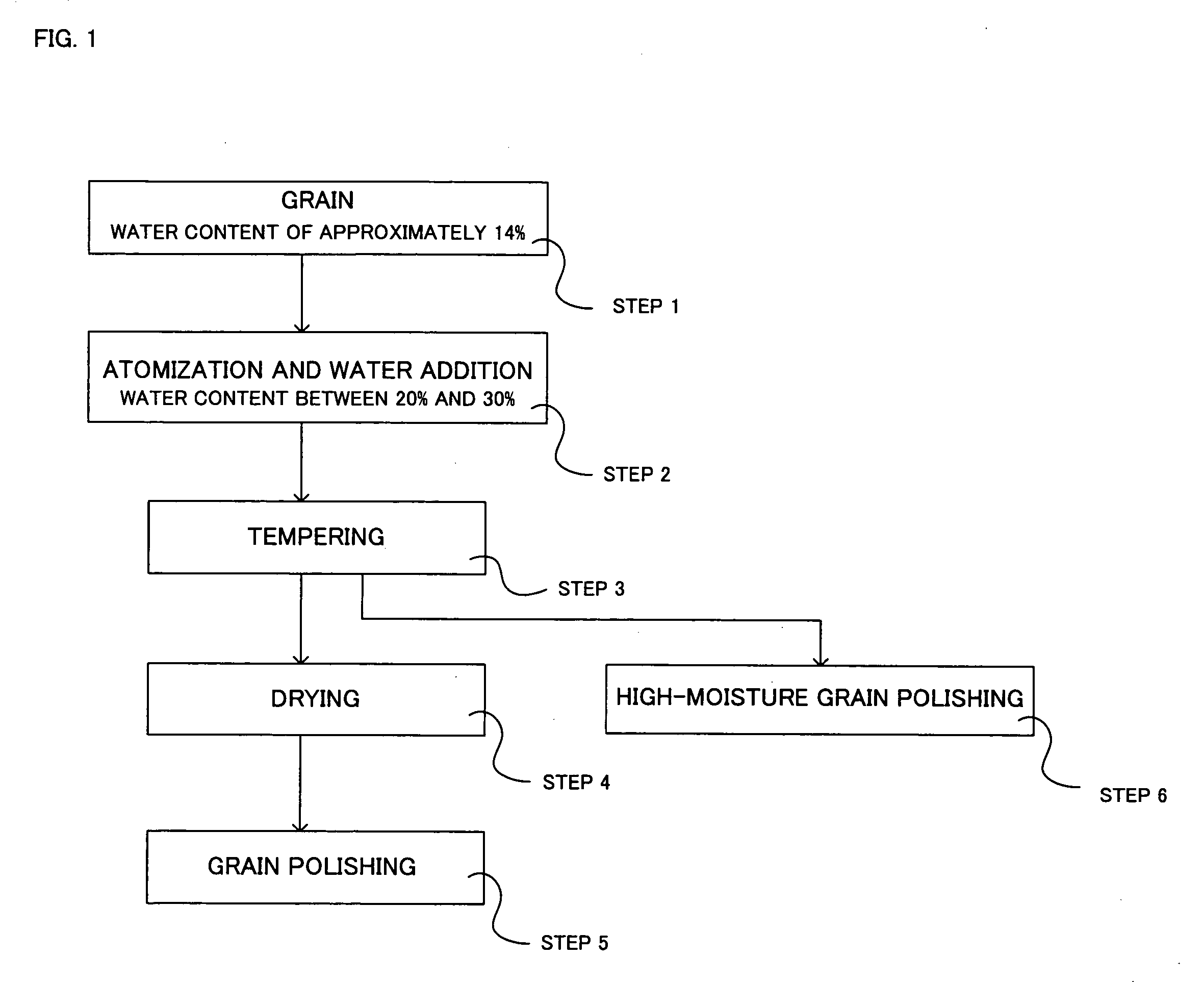Method for enriching ý-aminobutyric acid and cereal obtained by the method
a technology of which is applied in the field of enriching -aminobutyric acid and grain obtained by the method, can solve the problems of complex operation, risk of causing putrefaction, and impaired -aminobutyric acid during grain polishing, so as to prevent degeneration of grain, suppress grain denaturation, and slow water addition
- Summary
- Abstract
- Description
- Claims
- Application Information
AI Technical Summary
Benefits of technology
Problems solved by technology
Method used
Image
Examples
example 1
[0045] Brown rice was used as a raw material, and the water content thereof had previously been adjusted to approximately 14%. Thereafter, slow water addition was carried out, in order to provide a water content of 20% to 30%. In order not to cause rice break, such a slow water addition treatment was carried out at a rate of 0.5% / h, until the water content reached 17%. After the water content exceeded 17%, the water addition rate was gradually increased to a rate of 0.5% to 0.9% / h. As such water to be added, drinkable water such as running water, distilled water, well water, acidic-water, or electrolytic saline water, is preferable. In particular, when sterilization is also intended, a hypochlorite solution having an effective chlorine concentration between 0.1 ppm and 50 ppm may also be used. A preferred water addition method comprises spraying water, in order to add cloudy water droplets onto the surface of brown rice. The diameter of such an atomized water droplet was set at 0.1 ...
example 2
[0047] Brown rice (“Hoshinoyume” or “Kirara”) was used as a raw material, and the water content thereof had previously been adjusted to approximately 14%. Thereafter, slow water addition was carried out, in order to provide a water content of 20% to 30%. In order not to cause rice break, such a slow water addition treatment was carried out at a rate of 0.5% / h, until the water content reached 17%. After the water content exceeded 17%, the water addition rate was gradually increased to a rate of 0.5% to 0.9% / h. As such water to be added, running water or distilled water is preferably used. When sterilization is also intended, a hypochlorite solution having an effective chlorine concentration between 0.1 ppm and 50 ppm may also be used. A preferred water addition method comprises spraying water, in order to add cloudy water droplets onto the surface of brown rice. The diameter of such an atomized water droplet was set at 0.1 mm or less. After completion of such water addition, the brow...
example 3
[0049] Wheat grain was used as a raw material, and the water content thereof had previously been adjusted to approximately 12%. Thereafter, slow water addition was carried out, in order to provide a water content of 21% to 25%. In order not to cause denaturation of the wheat grain, such a slow-water addition treatment was carried out by the aforementioned spray method at a water addition rate of 1.0% to 2.0% / h, until the water content reached 21% to 30%. As such water to be added, running water was used. After completion of such water addition, the wheat grain was transferred into a tank or the like, followed by tempering for 3 to 10 hours. The optimum environmental temperature during such tempering was set between 7° C. and 13° C., and outside air was introduced into the tank for ventilation. After completion of the tempering, the wheat grain was dried by a conventional drying method, until the water content thereof was adjusted to a degree suitable for milling. Thereafter, the whe...
PUM
 Login to View More
Login to View More Abstract
Description
Claims
Application Information
 Login to View More
Login to View More - R&D
- Intellectual Property
- Life Sciences
- Materials
- Tech Scout
- Unparalleled Data Quality
- Higher Quality Content
- 60% Fewer Hallucinations
Browse by: Latest US Patents, China's latest patents, Technical Efficacy Thesaurus, Application Domain, Technology Topic, Popular Technical Reports.
© 2025 PatSnap. All rights reserved.Legal|Privacy policy|Modern Slavery Act Transparency Statement|Sitemap|About US| Contact US: help@patsnap.com



